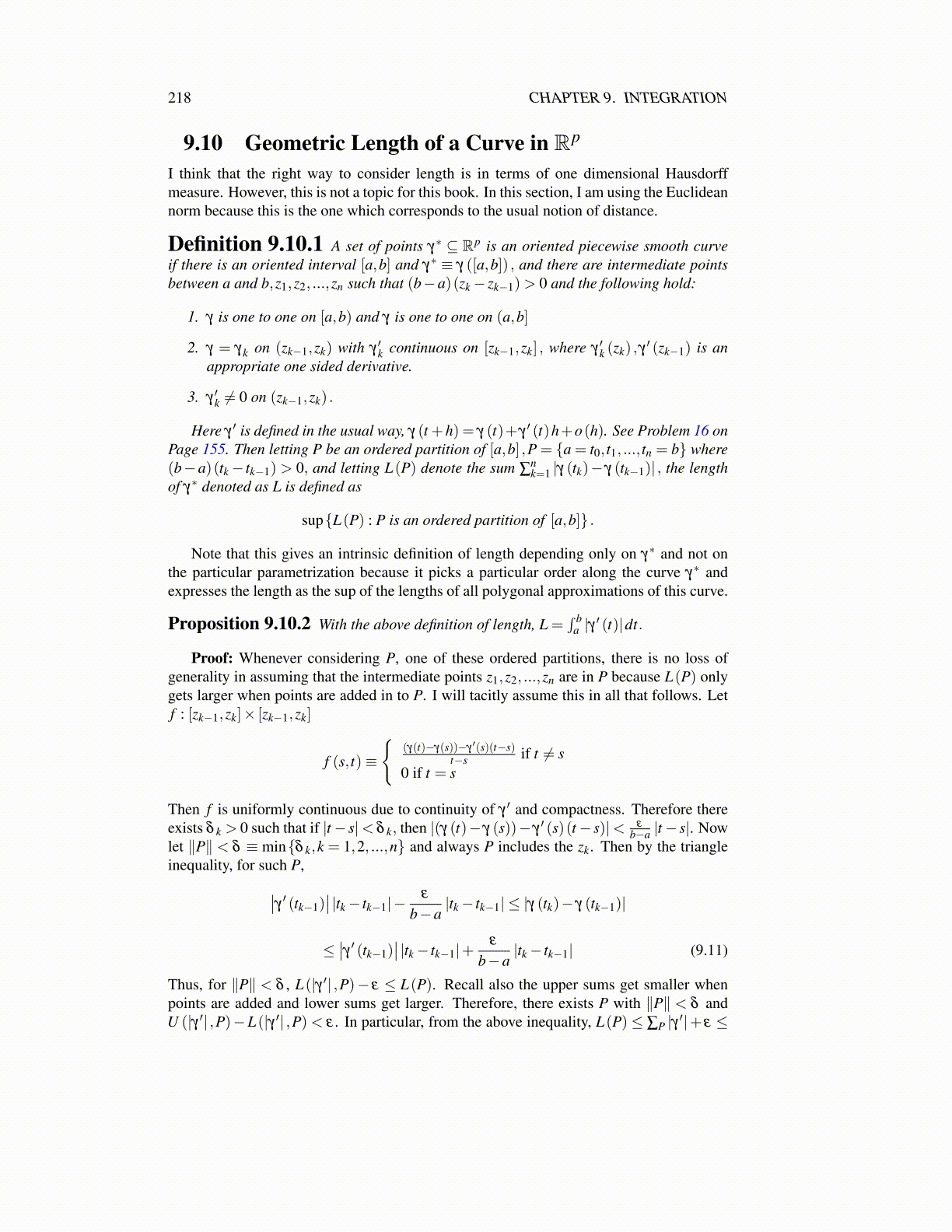
218 CHAPTER 9. INTEGRATION
14. Recall that for a power series, ∑∞k=0 ak (x− c)k you could differentiate term by term
on the interval of convergence. Show that if the radius of convergence of the aboveseries is r > 0 and if [a,b]⊆ (c− r,c+ r) , then
∫ b
a
∞
∑k=0
ak (x− c)k dx = a0 (b−a)+∞
∑k=1
ak
k(b− c)k+1−
∞
∑k=1
ak
k(a− c)k+1
In other words, you can integrate term by term.
15. Find ∑∞k=1
2−k
k .
16. Let f be Riemann integrable on [0,1] . Show directly that x→∫ x
0 f (t)dt is continu-ous. Hint: It is always assumed that Riemann integrable functions are bounded.
17. Suppose f ,g are two functions which are continuous with continuous derivativeson [a,b] . Show using the fundamental theorem of calculus and the product rule theintegration by parts formula. Also explain why all the terms make sense.∫ b
a f ′ (t)g(t)dt = f (b)g(b)− f (a)g(a)−∫ b
a f (t)g′ (t)dt
18. Show 11+x2 = ∑
nk=0 (−1)k x2k + (−1)n+1x2n+2
1+x2 .Now use this to find a series which con-verges to arctan(1) = π/4. Recall arctan(x) =
∫ x0
11+t2 dt. For which values of x will
your series converge? For which values of x does the above description of arctanin terms of an integral make sense? Does this help to show the inferiority of powerseries?
19. Define F (x) ≡∫ x
01
1+t2 dt. Of course F (x) = arctan(x) as mentioned above but justconsider this function in terms of the integral. Sketch the graph of F using only itsdefinition as an integral. Show there exists a constant M such that −M ≤ F (x)≤M.Next explain why limx→∞ F (x) exists and show this limit equals − limx→−∞ F (x).
20. In Problem 19 let the limit defined there be denoted by π/2 and define T (x) ≡F−1 (x) for x ∈ (−π/2,π/2) . Show T ′ (x) = 1+ T (x)2 and T (0) = 0. As part of
this, you must explain why T ′ (x) exists. For x ∈ [0,π/2] let C (x) ≡ 1/√
1+T (x)2
with C (π/2) = 0 and on [0,π/2] , define S (x) by√
1−C (x)2. Show both S (x) andC (x) are differentiable on [0,π/2] and satisfy S′ (x) =C (x) and C′ (x) =−S (x) . Findthe appropriate way to define S (x) and C (x) on all of [0,2π] in order that these func-tions will be sin(x) and cos(x) and then extend to make the result periodic of period2π on all of R. Note this is a way to define the trig. functions which is independentof plane geometry and also does not use power series. See the book by Hardy, [14]for this approach, if I remember right.
21. Show arcsin(x) =∫ x
01√1−t2
dt. Now use the binomial theorem to find a power series
for arcsin(x) .
22. The initial value problem from ordinary differential equations is of the form y′ =f (y) , y(0) = y0. Suppose f is a continuous function of y. Show that a function t→y(t) solves the above initial value problem if and only if y(t) = y0 +
∫ t0 f (y(s))ds.